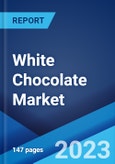White chocolate is a blend of cocoa butter, sugar, milk products, vanilla, and lecithin, which is a fatty emulsifier assisting in combining different ingredients. Its consumption can be associated with various health benefits, such as elevating mood, boosting immunity, improving digestion, relieving stress, and lowering the risk of hypertension and heart failure. Presently, it is available in different colors, including white, pale yellow, or ivory, and is widely used in numerous snacks and beverages, such as cookies, popcorns, cupcakes, milkshakes, coffee, and smoothies.
White Chocolate Market Trends:
The increasing consumption of confectionery items on account of rapid urbanization and changing consumer preferences, tastes, and eating habits represent one of the key factors impelling market growth. Moreover, the rising awareness about the health benefits of white chocolate, such as improving low blood sugar levels for people suffering from hypoglycemia, is driving the market further. Apart from this, due to the high presence of cocoa butter, white chocolate is extensively utilized in formulating various cosmetic and personal care products, such as lotions, lip balms, hair removal wax, nail enamel, and anti-aging and scar-reducing topical treatments. It assists the skin in forming a thin protective barrier that locks in moisture and blocks out harsh outside elements. Besides this, key manufacturers are using fruit powders to produce sugar-free chocolates. They are also introducing vegan variants made using plant-based milk alternatives like oat, soy, or coconut. This, in confluence with the emerging adoption of veganism, is anticipated to impel the growth of the market in the coming years.Key Market Segmentation:
The publisher provides an analysis of the key trends in each segment of the global white chocolate market report, along with forecasts at the global and regional levels from 2023-2028. The report has categorized the market based on distribution channel.Breakup by Distribution Channel:
- Supermarkets and Hypermarkets
- Convenience Stores
- Non-Grocery Retailers
- Others
Breakup by Key Regions:
- Western Europe
- North America
- Eastern Europe
- Asia
- Latin America
- The Middle East and Africa
- Australasia
Competitive Landscape:
The competitive landscape of the market has been analyzed in the report, along with the detailed profiles of the major players operating in the industry.This report provides a deep insight into the global white chocolate industry covering all its essential aspects. This ranges from a macro overview of the market to micro details of the industry performance, recent trends, key market drivers and challenges, SWOT analysis, Porter’s five forces analysis, value chain analysis, etc. The report also provides a comprehensive analysis for setting up a white chocolate manufacturing plant. The study analyses the processing and manufacturing requirements, project cost, project funding, project economics, expected returns on investment, profit margins, etc. This report is a must-read for entrepreneurs, investors, consultants, and all those who have any kind of stake or are planning to foray into the white chocolate industry in any manner.
Key Questions Answered in This Report
1. What was the size of the global white chocolate market in 2022?2. What is the expected growth rate of the global white chocolate market during 2023-2028?
3. What are the key factors driving the global white chocolate market?
4. What has been the impact of COVID-19 on the global white chocolate market?
5. What is the breakup of the global white chocolate market based on the distribution channel?
6. What are the key regions in the global white chocolate market?
Table of Contents
Methodology

LOADING...
Table Information
| Report Attribute | Details |
|---|---|
| No. of Pages | 147 |
| Published | September 2023 |
| Forecast Period | 2022 - 2028 |
| Estimated Market Value ( USD | $ 18.7 Billion |
| Forecasted Market Value ( USD | $ 21.2 Billion |
| Compound Annual Growth Rate | 2.1% |
| Regions Covered | Global |









